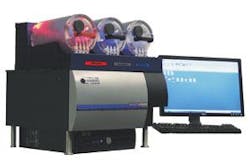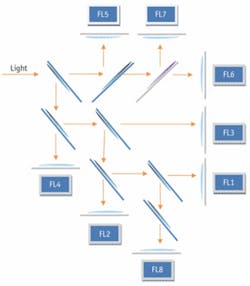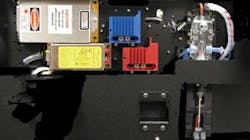Flow cytometry’s new scalability
ROSA CHANG
During the past 40 years, flow cytometers have become an integral part of the scientific community’s toolbox. These versatile instruments are widely used in a variety of cellular analysis applications from cell counting to plant biology, immunology, and microbiology. The recent availability of fluorescent reagents and increased need for high-content screening (HCS) have made this method of cell analysis very important for drug discovery and personalized medicine (clinical diagnosis). Despite all these benefits, though, flow cytometers have not reached their potential in the market.
Most high-performance units—that is, cytometers with resolution under 2%CV (percent coefficient of variation) and superior sensitivity (eight peak rainbow beads)—are large, difficult to use, and configured for high-end applications (minimum two lasers/five colors). Those that are configurable are typically expensive because of their architecture. For example, their beam-shaping optics and electronics are designed for the most complex configuration, which translates into higher costs for the end user, whether or not they need this particular functionality. Low-cost instruments, on the other hand, lack the performance of their high-end counterparts. In addition, because of their limited capabilities, the instruments must be replaced as the researchers’ needs change, creating several logistics problems. The laboratories’ staff needs to be retrained, the outgoing piece of capital equipment must be dealt with (sold or scrapped), and a larger physical space must be allocated for the new instrument. On the upside, lower-end instruments tend to be smaller and less intimidating; and because they target a specific set of applications they also tend to be more user friendly.
Advantages of both
Now it’s possible to get high-performance (resolution and sensitivity) even with the minimum number of lasers and colors. Stratedigm’s S1000 (see Fig. 1) is designed to offer scalability in terms of both price and performance. Several new technologies are incorporated in the design that enable it to offer advantages of instruments at both ends of the spectrum. One of the cornerstones of the design is a high-performance architecture, which can detect dim signals and resolve similar populations more broadly available.
In addition, the instrument is designed to be smaller, easier to use, and more reliable than existing models. For example, its patent-pending sample-injection architecture eliminates the need to replace o-rings that wear over time. Because of its small footprint and light weight it can be used on any standard desktop, and ultrastable optics allow users to move the unit in their lab without having to make a special service call, as with higher-end instruments.
High-power solid-state lasers allow the tool to be smaller, more reliable, and more sensitive. In the past, typical applications required the use of only two lasers and four colors, but this situation is changing rapidly as increasingly complex assays require more parameters, both for clinical and research applications. Clinical labs are trying to get more data on infectious diseases such as HIV, hepatitis, and HPV, all using the same panel for the same patient. Research scientists need near-UV lasers to complement their existing blue and red lasers and for using quantum dots.
One of the greatest benefits of the S1000 series is the fact that it can be configured from a 1-laser/6-parameter (forward scatter, side scatter, time, and three colors) system to a 4-laser/11-parameter system, and the customer pays only for what is needed. As the users’ needs change, the system can be upgraded to meet new demands.
Both the emission and excitation optics are also configurable and scalable. Each laser has its own beam-shaping optics, and, the patented, high-efficiency emissions block (see Fig. 2) houses up to nine photomultiplier tubes, or PMTs (eight colors plus one scatter), enabling the opportunity to configure as many colors per laser as an application requires. It does this by minimizing transmission losses through the use of dichroic filters, using reflection instead of transmission to channel the light to the last detectors. This proprietary design increases collection efficiency by up to 20%.The electronics design consists of several identical but independent motherboards, each of which supports up to six detectors and can work in conjunction with another board to increase the number of parameters supported by the instrument. A 16-bit ADC coupled with high-end log amps provides clean data for height, area, and width measurements on linear and log scales simultaneously. The basic system is configured with a single board, because it needs to support only one or two lasers, two scatters, and three or four colors; adding a second board allows the system to handle up to 11 parameters and four lasers.
The S1000 can accommodate up to four lasers internally, but users can choose from up to five sources, including a 372 nm source, designed by Coherent to meet the specific needs of Stratedigm customers for a small package near-UV source. The core of Stratedigm’s optical design is in its monolithic optical-plate architecture, in which two lasers are mounted on the front and the other two are mounted symmetrically on the backside. The spatially separated beams are combined using dichroic filters.
Performance: the differentiator
What is the inherent difference between high-end and low-end instruments? Why would users prefer to buy a 15-year-old FACScan over a newer, less expensive flow cytometer? The answer is simply performance.
One of the biggest problems with current inexpensive flow cytometers is their inability to hold tight CVs and distinguish signals that are four decades in intensity (eight distinct peaks of rainbow beads). By keeping tight CVs (under 2.5%) and resolving eight peaks, the S1000 can provide excellent performance regardless of unit configuration (see Fig. 3).In addition, lower-cost units reduce scatters performance to bring down overall cost. In some cases, manufacturers choose not to ship one of the scatters, or to use lower-sensitivity detectors. The S1000 uses a PMT to check side scatter and a high-end photodiode for forward scatter. Both of these collection optics are from Hamamatsu.
For flow cytometers to become more mainstream instruments, they must be ultrareliable. But reliability of optics is a shortcoming of today’s designs. It has been considered by some to be nearly impossible to ensure that all excitation sources, beam-shaping optics, flow cell, and collection optics move relative to each other during temperature variations or system relocation. At issue is the need to cool so many elements at the same rate. Stratedigm’s design mounts all optical components on a single plate, thus maintaining all elements relative to each other (see Fig. 4).While a simple concept, it was extremely difficult to realize, and the design had to be adjusted several times to ensure that all elements were properly cooled. A single, half-inch aluminum plate holds up to four lasers symmetrically: two are mounted on the front and the other two reside on the back. To maximize laser performance, the designers chose not to fiber-couple the beams, which made the assembly’s thermal design very challenging. Because the optical plate is less than 20 in. long by 6 in. high, almost every available surface was used. Bending the beams from the lasers placed on the back of the plate required several months of calculations and testing to ensure reliability.
Configurability applied
One of Stratedigm’s first customers configured the unit to have blue, red, green, and violet lasers. The design had the green and blue lasers share the same detectors, and spatially separated the signals from the red and violet lasers. The configuration was required in the customer’s lab, but their existing high-end analyzer could not provide for the need. Only a configurable system would do.
Other customers have been able to reduce their QA protocols and save hours of test time each day because of the S1000’s built-in diagnostics feature. Further, its built-in database enables core lab managers to use software to manage all of their flow-cytometry data in their lab regardless of which instrument was used to collect them.
The modular design of this new generation of flow cytometers truly enables customers to fill several gaps between traditional high- and low-end options.
Rosa Chang is cofounder of Stratedigm, San Jose BioCenter, 5941 Optical Court, San Jose, CA 95138. She has a BS in Mechanical Engineering, an MS in Engineering, and an MBA. An alumnus of BD Biosciences, she helped design BD FACSCanto’s flowcell. She serves as Stratedigm’s new business development manager. Contact her at [email protected]; www.stratedigm.com.



